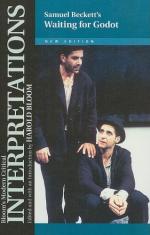|
This section contains 7,228 words (approx. 25 pages at 300 words per page) |

|
SOURCE: Wood, Rupert. “An Endgame of Aesthetics: Beckett as Essayist.” In The Cambridge Companion to Beckett, edited by John Pilling, pp. 1-16. Cambridge: Cambridge University Press, 1994.
In the following essay, Wood analyzes Beckett's essays as lying on a continuum between systematic philosophy on one end and self-deconstruction on the other.
Whilst it is easy to see where Beckett's discursive writing begins, it is difficult to see where, or how, it ends. It is possible to outline the loose assemblage of aesthetic theories and philosophical ideas that form their point of departure, but it is extremely difficult to see what happens to these ideas and where they end up. Beckett's two major early essays, ‘Dante … Bruno.Vico..Joyce’ (1929) and Proust (1931) are founded upon fairly coherent systems of philosophy and aesthetics. The rest of his pre-war discursive writing, which consists mainly of short literary reviews, can with care be unpicked...
|
This section contains 7,228 words (approx. 25 pages at 300 words per page) |

|


